2004 CHEVROLET TRAIL BLAZER wheel torque
[x] Cancel search: wheel torquePage 89 of 448
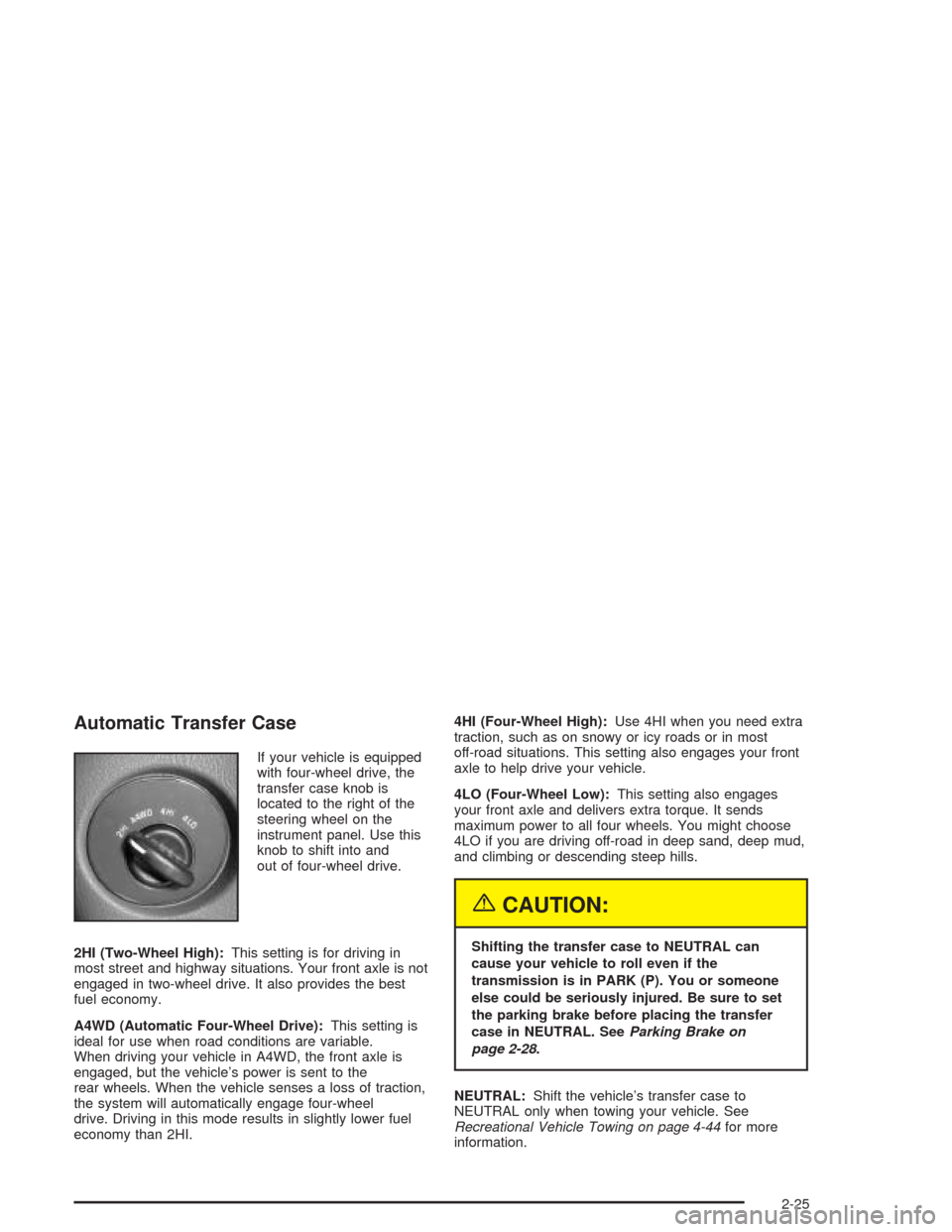
Automatic Transfer Case
If your vehicle is equipped
with four-wheel drive, the
transfer case knob is
located to the right of the
steering wheel on the
instrument panel. Use this
knob to shift into and
out of four-wheel drive.
2HI (Two-Wheel High):This setting is for driving in
most street and highway situations. Your front axle is not
engaged in two-wheel drive. It also provides the best
fuel economy.
A4WD (Automatic Four-Wheel Drive):This setting is
ideal for use when road conditions are variable.
When driving your vehicle in A4WD, the front axle is
engaged, but the vehicle’s power is sent to the
rear wheels. When the vehicle senses a loss of traction,
the system will automatically engage four-wheel
drive. Driving in this mode results in slightly lower fuel
economy than 2HI.4HI (Four-Wheel High):Use 4HI when you need extra
traction, such as on snowy or icy roads or in most
off-road situations. This setting also engages your front
axle to help drive your vehicle.
4LO (Four-Wheel Low):This setting also engages
your front axle and delivers extra torque. It sends
maximum power to all four wheels. You might choose
4LO if you are driving off-road in deep sand, deep mud,
and climbing or descending steep hills.
{CAUTION:
Shifting the transfer case to NEUTRAL can
cause your vehicle to roll even if the
transmission is in PARK (P). You or someone
else could be seriously injured. Be sure to set
the parking brake before placing the transfer
case in NEUTRAL. SeeParking Brake on
page 2-28.
NEUTRAL:Shift the vehicle’s transfer case to
NEUTRAL only when towing your vehicle. See
Recreational Vehicle Towing on page 4-44for more
information.
2-25
Page 335 of 448
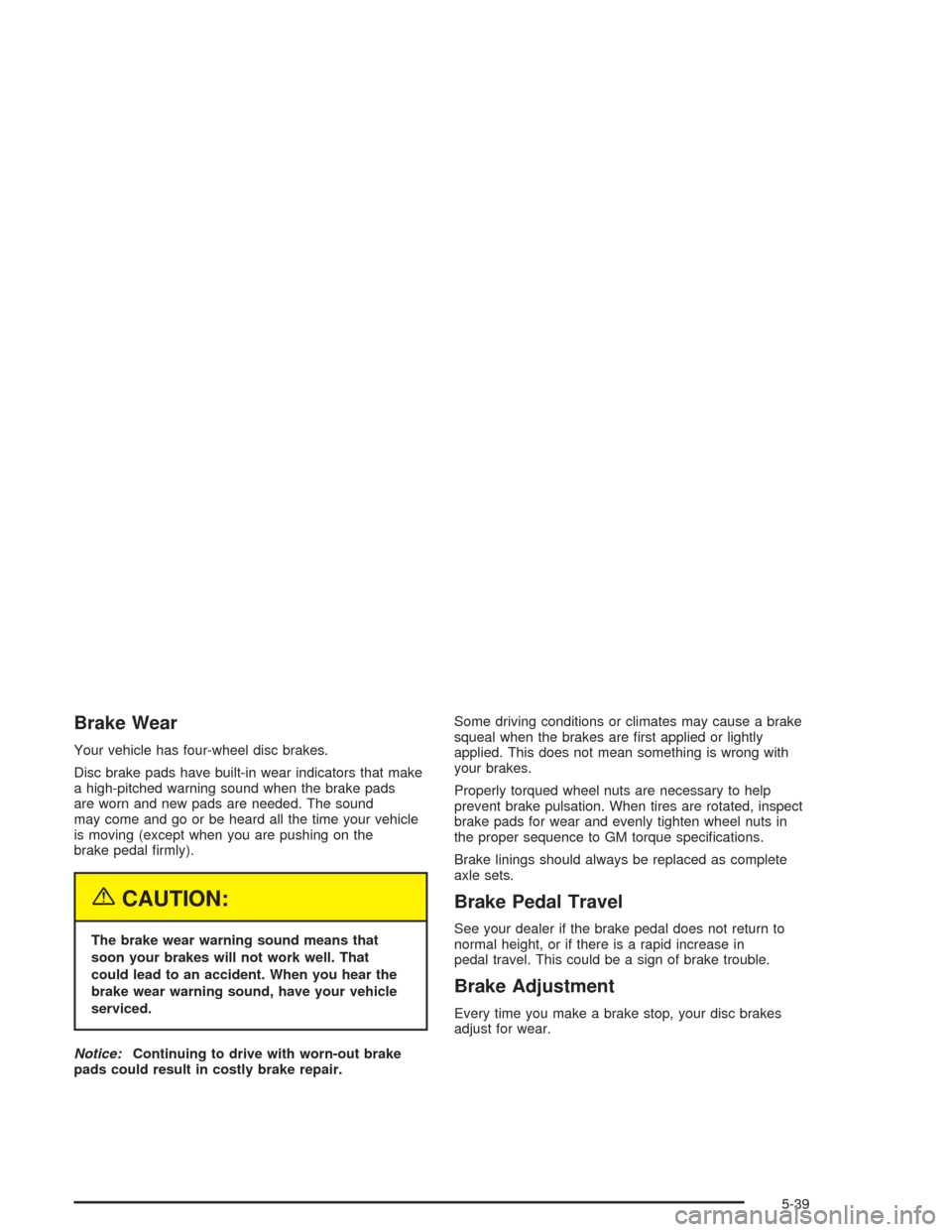
Brake Wear
Your vehicle has four-wheel disc brakes.
Disc brake pads have built-in wear indicators that make
a high-pitched warning sound when the brake pads
are worn and new pads are needed. The sound
may come and go or be heard all the time your vehicle
is moving (except when you are pushing on the
brake pedal �rmly).
{CAUTION:
The brake wear warning sound means that
soon your brakes will not work well. That
could lead to an accident. When you hear the
brake wear warning sound, have your vehicle
serviced.
Notice:Continuing to drive with worn-out brake
pads could result in costly brake repair.Some driving conditions or climates may cause a brake
squeal when the brakes are �rst applied or lightly
applied. This does not mean something is wrong with
your brakes.
Properly torqued wheel nuts are necessary to help
prevent brake pulsation. When tires are rotated, inspect
brake pads for wear and evenly tighten wheel nuts in
the proper sequence to GM torque speci�cations.
Brake linings should always be replaced as complete
axle sets.
Brake Pedal Travel
See your dealer if the brake pedal does not return to
normal height, or if there is a rapid increase in
pedal travel. This could be a sign of brake trouble.
Brake Adjustment
Every time you make a brake stop, your disc brakes
adjust for wear.
5-39
Page 358 of 448
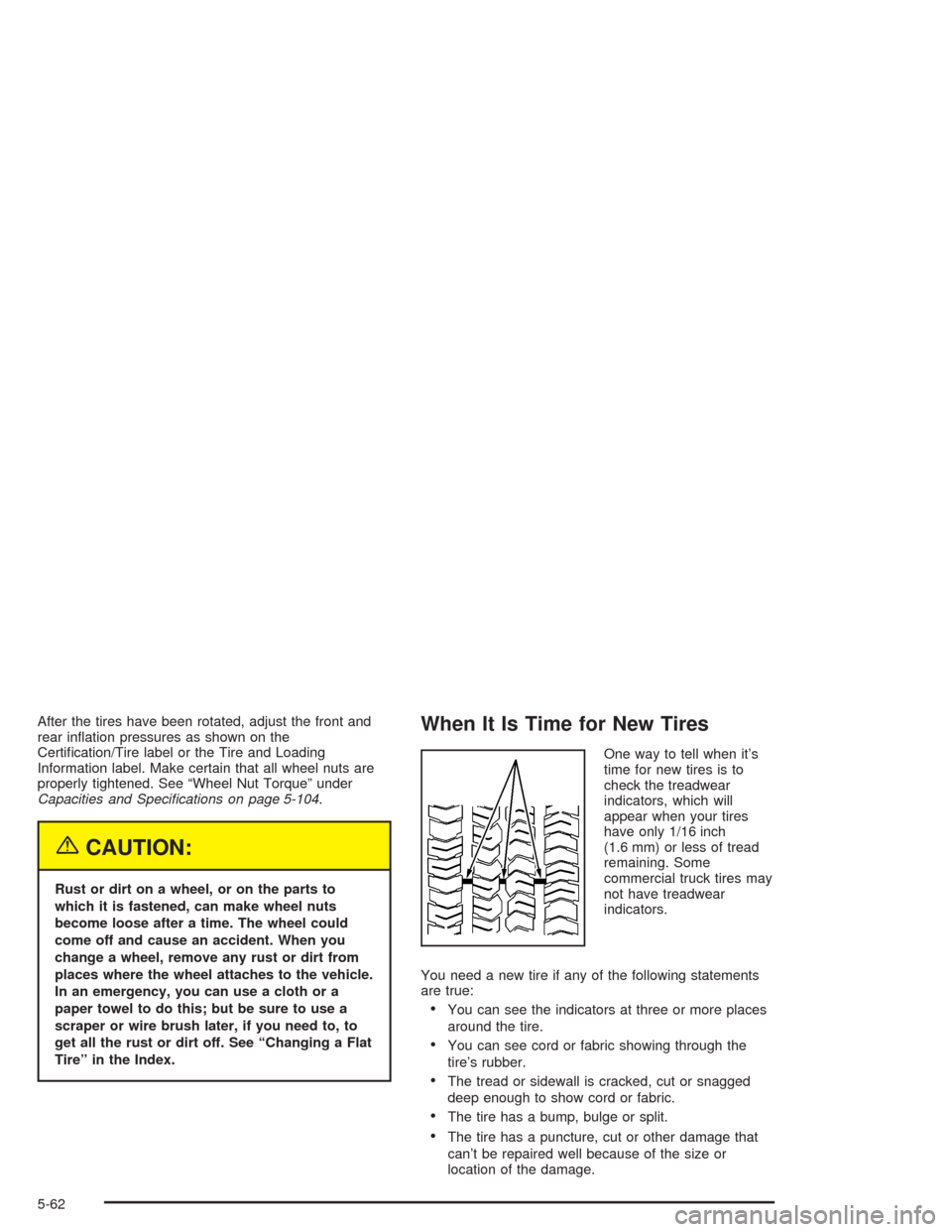
After the tires have been rotated, adjust the front and
rear in�ation pressures as shown on the
Certi�cation/Tire label or the Tire and Loading
Information label. Make certain that all wheel nuts are
properly tightened. See “Wheel Nut Torque” under
Capacities and Speci�cations on page 5-104.
{CAUTION:
Rust or dirt on a wheel, or on the parts to
which it is fastened, can make wheel nuts
become loose after a time. The wheel could
come off and cause an accident. When you
change a wheel, remove any rust or dirt from
places where the wheel attaches to the vehicle.
In an emergency, you can use a cloth or a
paper towel to do this; but be sure to use a
scraper or wire brush later, if you need to, to
get all the rust or dirt off. See “Changing a Flat
Tire” in the Index.
When It Is Time for New Tires
One way to tell when it’s
time for new tires is to
check the treadwear
indicators, which will
appear when your tires
have only 1/16 inch
(1.6 mm) or less of tread
remaining. Some
commercial truck tires may
not have treadwear
indicators.
You need a new tire if any of the following statements
are true:
You can see the indicators at three or more places
around the tire.
You can see cord or fabric showing through the
tire’s rubber.
The tread or sidewall is cracked, cut or snagged
deep enough to show cord or fabric.
The tire has a bump, bulge or split.
The tire has a puncture, cut or other damage that
can’t be repaired well because of the size or
location of the damage.
5-62
Page 375 of 448
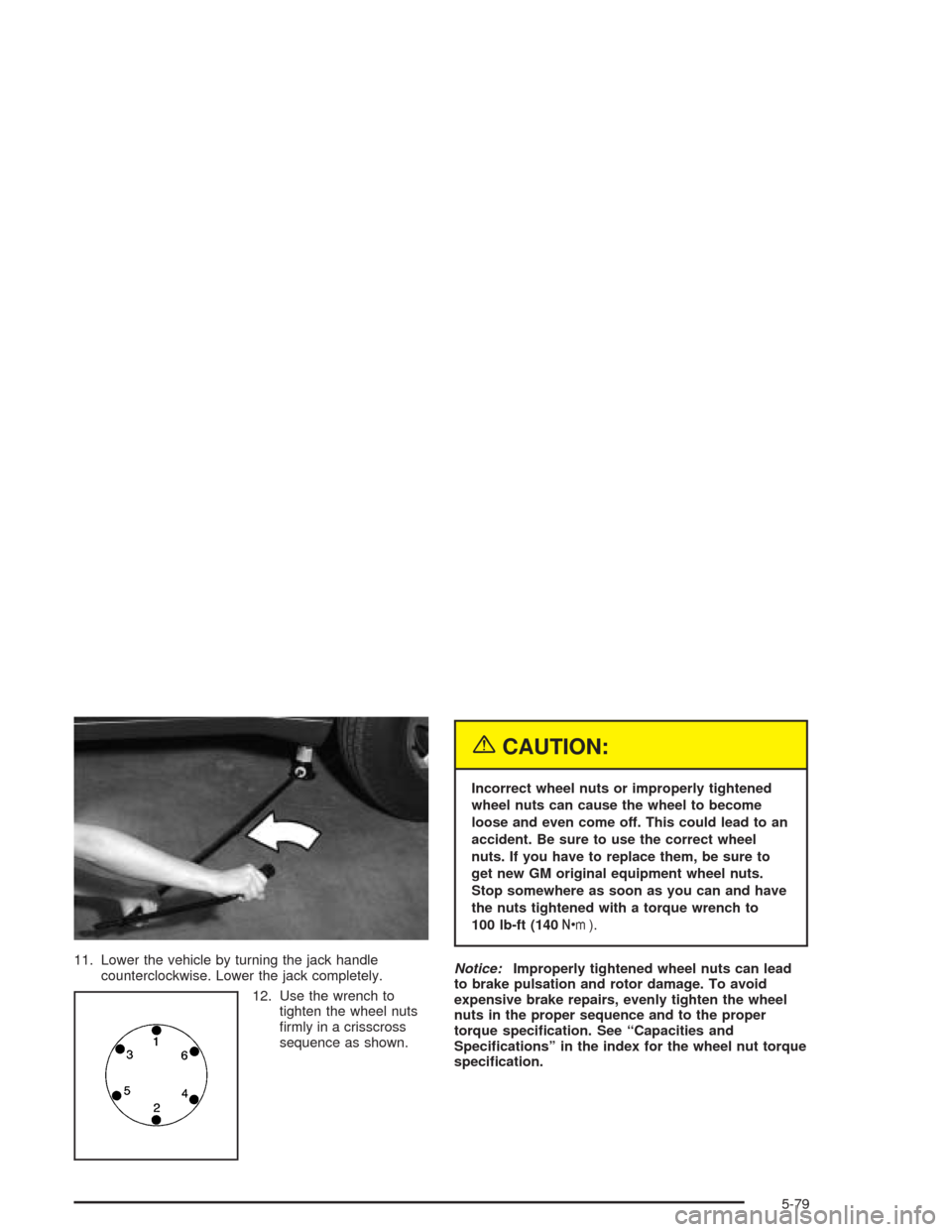
11. Lower the vehicle by turning the jack handle
counterclockwise. Lower the jack completely.
12. Use the wrench to
tighten the wheel nuts
�rmly in a crisscross
sequence as shown.
{CAUTION:
Incorrect wheel nuts or improperly tightened
wheel nuts can cause the wheel to become
loose and even come off. This could lead to an
accident. Be sure to use the correct wheel
nuts. If you have to replace them, be sure to
get new GM original equipment wheel nuts.
Stop somewhere as soon as you can and have
the nuts tightened with a torque wrench to
100 lb-ft (140Y).
Notice:Improperly tightened wheel nuts can lead
to brake pulsation and rotor damage. To avoid
expensive brake repairs, evenly tighten the wheel
nuts in the proper sequence and to the proper
torque speci�cation. See “Capacities and
Speci�cations” in the index for the wheel nut torque
speci�cation.
5-79
Page 400 of 448
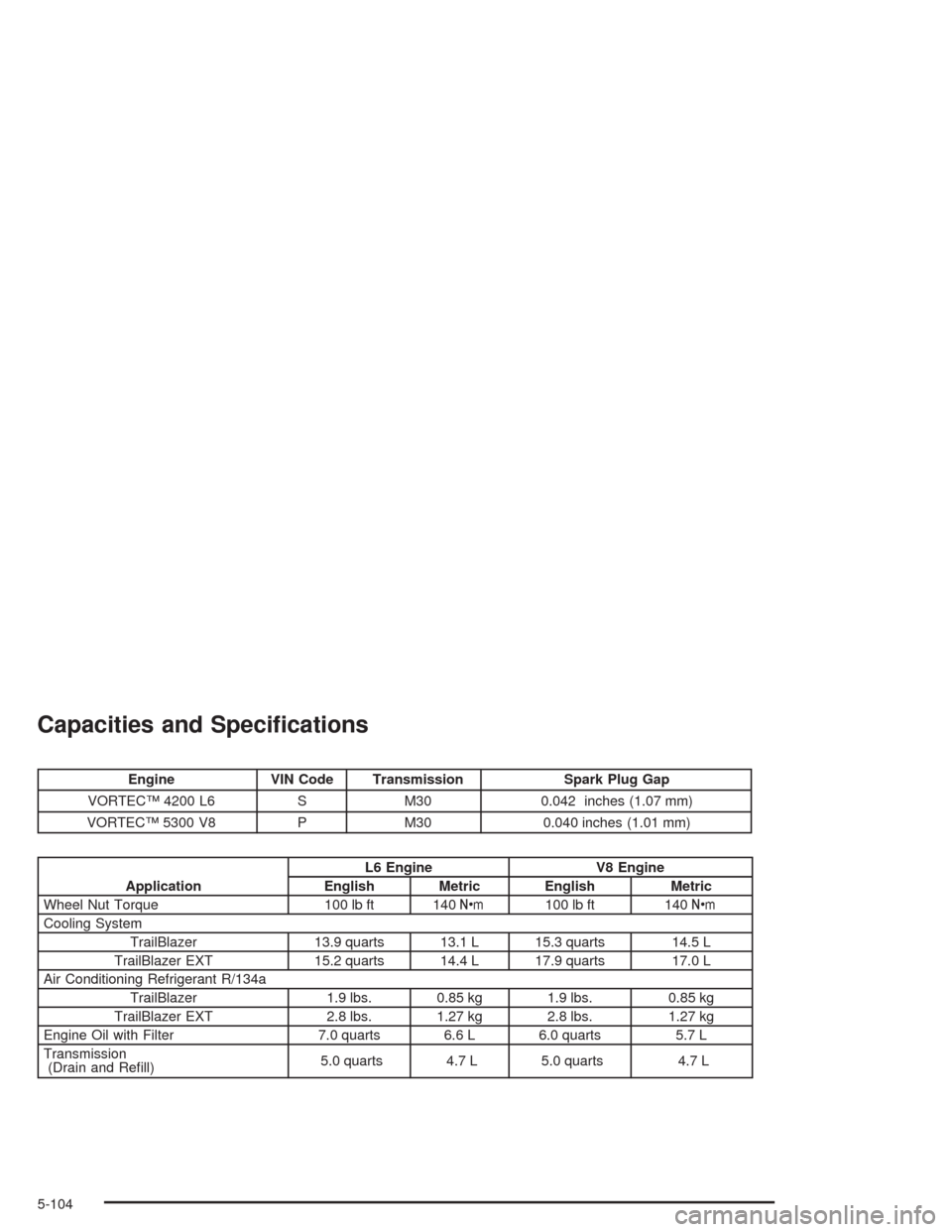
Capacities and Speci�cations
Engine VIN Code Transmission Spark Plug Gap
VORTEC™ 4200 L6 S M30 0.042 inches (1.07 mm)
VORTEC™ 5300 V8 P M30 0.040 inches (1.01 mm)
ApplicationL6 Engine V8 Engine
English Metric English Metric
Wheel Nut Torque 100 lb ft 140Y100 lb ft 140Y
Cooling System
TrailBlazer 13.9 quarts 13.1 L 15.3 quarts 14.5 L
TrailBlazer EXT 15.2 quarts 14.4 L 17.9 quarts 17.0 L
Air Conditioning Refrigerant R/134a
TrailBlazer 1.9 lbs. 0.85 kg 1.9 lbs. 0.85 kg
TrailBlazer EXT 2.8 lbs. 1.27 kg 2.8 lbs. 1.27 kg
Engine Oil with Filter 7.0 quarts 6.6 L 6.0 quarts 5.7 L
Transmission
(Drain and Re�ll)5.0 quarts 4.7 L 5.0 quarts 4.7 L
5-104
Page 446 of 448
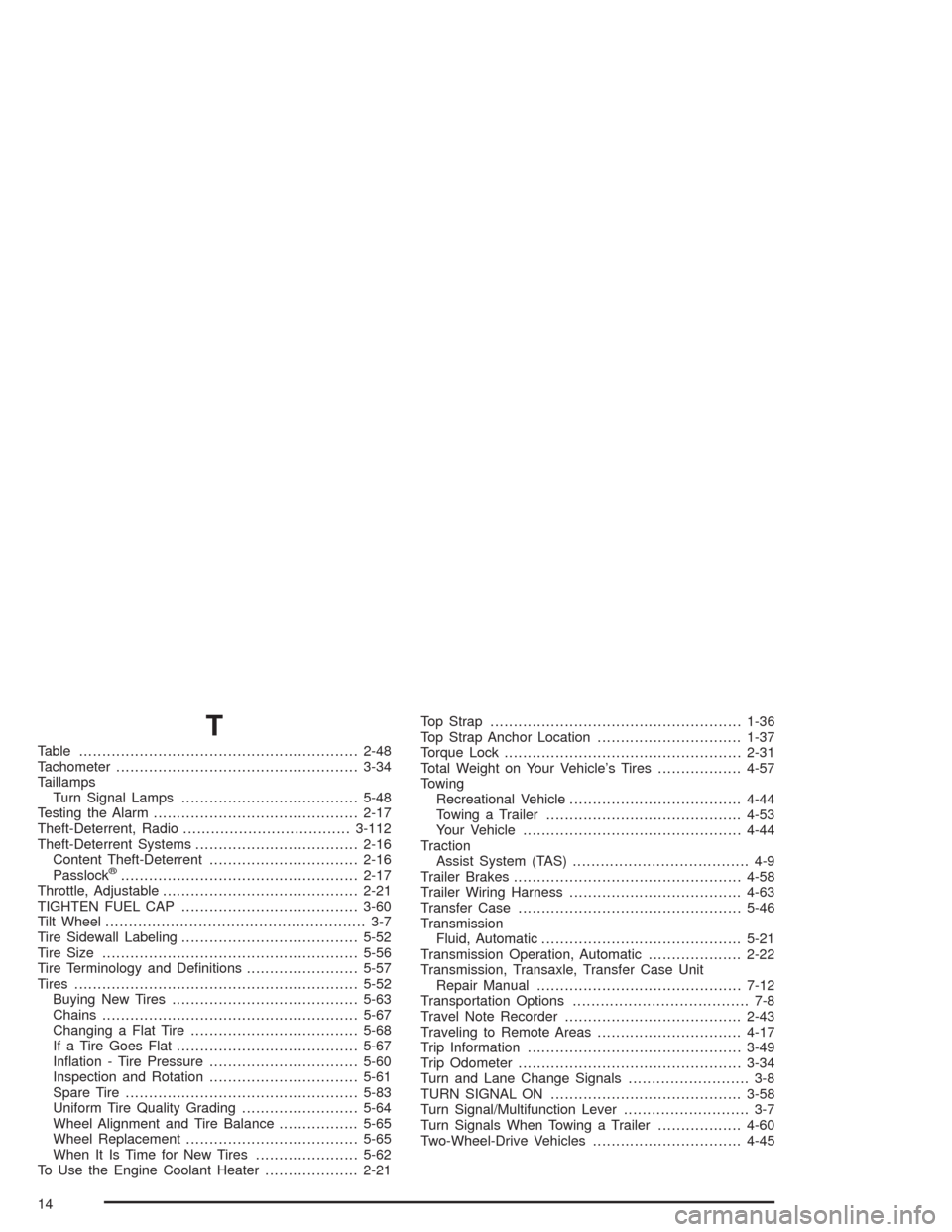
T
Table............................................................2-48
Tachometer....................................................3-34
Taillamps
Turn Signal Lamps......................................5-48
Testing the Alarm............................................2-17
Theft-Deterrent, Radio....................................3-112
Theft-Deterrent Systems...................................2-16
Content Theft-Deterrent................................2-16
Passlock
®...................................................2-17
Throttle, Adjustable..........................................2-21
TIGHTEN FUEL CAP......................................3-60
Tilt Wheel........................................................ 3-7
Tire Sidewall Labeling......................................5-52
Tire Size.......................................................5-56
Tire Terminology and De�nitions........................5-57
Tires.............................................................5-52
Buying New Tires........................................5-63
Chains.......................................................5-67
Changing a Flat Tire....................................5-68
If a Tire Goes Flat.......................................5-67
In�ation - Tire Pressure................................5-60
Inspection and Rotation................................5-61
Spare Tire..................................................5-83
Uniform Tire Quality Grading.........................5-64
Wheel Alignment and Tire Balance.................5-65
Wheel Replacement.....................................5-65
When It Is Time for New Tires......................5-62
To Use the Engine Coolant Heater....................2-21Top Strap......................................................1-36
Top Strap Anchor Location...............................1-37
Torque Lock...................................................2-31
Total Weight on Your Vehicle’s Tires..................4-57
Towing
Recreational Vehicle.....................................4-44
Towing a Trailer..........................................4-53
Your Vehicle...............................................4-44
Traction
Assist System (TAS)...................................... 4-9
Trailer Brakes.................................................4-58
Trailer Wiring Harness.....................................4-63
Transfer Case................................................5-46
Transmission
Fluid, Automatic...........................................5-21
Transmission Operation, Automatic....................2-22
Transmission, Transaxle, Transfer Case Unit
Repair Manual............................................7-12
Transportation Options...................................... 7-8
Travel Note Recorder......................................2-43
Traveling to Remote Areas...............................4-17
Trip Information..............................................3-49
Trip Odometer................................................3-34
Turn and Lane Change Signals.......................... 3-8
TURN SIGNAL ON.........................................3-58
Turn Signal/Multifunction Lever........................... 3-7
Turn Signals When Towing a Trailer..................4-60
Two-Wheel-Drive Vehicles................................4-45
14